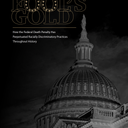
Inadequate testing, resistance to contact tracing, and poor social distancing practices likely made the thirteen federal executions in 2020 – 2021 COVID-19 superspreader events, the Associated Press has concluded. In the ten days after the December 10, 2020 execution of Brandon Bernard, 70% of prisoners on federal death row and hundreds of others incarcerated in the Terre Haute Correctional Complex where the executions took place tested positive for COVID-19. At least a dozen others who participated in the executions, including media witnesses, a spiritual advisor, and correctional staff who traveled from across the country for the executions, also contracted the disease.
The protocols surrounding the executions ignored public health advice for reducing the spread of the virus and warnings from medical experts about the risks. “These are the type of high-risk superspreader events that the [American Medical Association] and [the Centers for Disease Control and Prevention] have been warning against throughout the pandemic,” James L. Madara, the executive vice president of the AMA, wrote to the Department of Justice on January 11, 2021, two days before the execution of Lisa Montgomery.
Prison staff reportedly advised colleagues to travel home before being tested for COVID, noting that this sequence would allow them to avoid having to quarantine in Indiana. The Department of Justice said in a court filing that only six members of the team that conducted the November 19, 2020 execution of Orlando Hall opted to be tested while in Terre Haute. All six tested negative, but within a few days, eight members of the team had tested positive. Five of those eight were brought back for other executions just a few weeks later, which the Bureau of Prisons (BOP) insisted was in keeping with guidance from the Centers for Disease Control and Prevention (CDC) that called for at least ten days of isolation after a positive test. Yusuf Ahmed Nur, the spiritual advisor for Hall, also tested positive after the execution. “I could not say no to a man who would soon be killed,” Nur wrote. “That I contracted COVID-19 in the process was collateral damage” of executions during a pandemic.
When two media witnesses informed the BOP that they had tested positive for COVID after attending the January 2021 federal executions, the Bureau made no effort to conduct contact tracing and withheld the information from other execution witnesses who potentially had been exposed to the virus. Witnesses were required to wear masks but were driven in vans with poor ventilation where social distancing was impossible, and the witness rooms were too small to permit adequate social distancing. After witnesses reported that members of the execution team had not worn masks during parts of the earlier executions, a federal judge in Indiana ordered BOP to ensure that team members wore their masks. Even after that court order, however, witnesses said an executioner and a U.S. Marshal removed their masks during one of the January 2021 executions and BOP officials claimed in affidavits submitted to the court that they had substantially complied with the court order.
Other BOP policies also likely contributed to the spread of the virus, AP found. Prison staff were deemed “clear to work” if they were not experiencing COVID symptoms, without testing to determine if they were asymptomatic COVID carriers. Even when staff members traveled to participate in executions, they were not required to be tested for the disease. “We cannot force staff members to take tests, nor does the CDC recommend testing of asymptomatic individuals,” an agency spokesperson told AP.
After Dustin Higgs and Corey Johnson tested positive in December, death row was put on lockdown. But rather than delay their executions, BOP continued to move the two men around the prison to use phones and email to communicate with their lawyers as their executions approached. Those movements easily could have spread the virus to the guards who accompanied the two prisoners.
“The executions at the end of Donald Trump’s presidency, completed in a short window over a few weeks, likely acted as a superspreader event, according to the records reviewed by AP,” the news service said. “It was something health experts warned could happen when the Justice Department insisted on resuming executions during a pandemic.”
Michael Tarm, Michael Balsamo, and Michael R. Sisak, AP Analysis, Federal executions likely a COVID superspreader, Associated Press, February 5, 2021.



